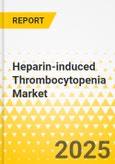This report comes with 10% free customization, enabling you to add data that meets your specific business needs.
Diagnosis of HIT involves a combination of clinical assessment, platelet count monitoring, and confirmatory laboratory testing for anti-PF4/heparin antibodies. Immediate management requires stopping all forms of heparin and initiating alternative non-heparin anticoagulants such as argatroban, bivalirudin, fondaparinux, or direct oral anticoagulants (DOACs) in certain cases. Early recognition and intervention are critical to preventing life-threatening complications. Current research is exploring targeted therapies, improved diagnostic assays, and risk stratification strategies to enhance patient safety while optimizing anticoagulant use. HIT remains an important focus for both clinicians and pharmaceutical companies developing safer anticoagulation options.
The growth of the global heparin-induced thrombocytopenia (HIT) market is primarily driven by the increasing use of heparin in surgical and hospital settings, particularly in cardiovascular surgeries, dialysis, and orthopaedic procedures, which significantly expands the patient pool at risk for developing HIT. Rising awareness among healthcare professionals, coupled with improved diagnostic protocols, has led to earlier and more accurate detection of the condition, thereby boosting the demand for effective treatment solutions. Additionally, the growing adoption of non-heparin anticoagulants such as argatroban, bivalirudin, and fondaparinux is contributing to market expansion, as these alternatives are preferred for their safety profile and efficacy in managing HIT.
The global heparin-induced thrombocytopenia (HIT) market faces several challenges, including low awareness in developing regions, where limited knowledge among healthcare providers in low- and middle-income countries results in underdiagnosis and delayed treatment. The high cost of alternative non-heparin anticoagulants further compounds the issue, as their premium pricing creates significant affordability barriers in resource-limited settings. Additionally, the complex diagnostic process, which often relies on specialized laboratory tests such as immunoassays and functional assays, can delay both diagnosis and treatment initiation, increasing the risk of severe complications for patients.
The competitive landscape of the global heparin-induced thrombocytopenia (HIT) market is rapidly evolving, driven by advancements in anticoagulant therapies, innovative diagnostic technologies, and precision medicine approaches. Leading companies such as Teva Pharmaceutical Industries Ltd., Aurobindo Pharma Limited, and Veralox Therapeutics are strengthening their portfolios with next-generation non-heparin anticoagulants, safer drug formulations, and novel targeted therapies designed to improve treatment efficacy, reduce recurrence risk, and enhance patient outcomes. The market is also benefiting from the increasing clinical adoption of advanced diagnostic tools, including rapid immunoassays, functional assays, and AI-enabled risk prediction systems, which enable earlier detection and timely intervention.
Growing government initiatives and hospital protocols aimed at improving HIT awareness, particularly in high-risk surgical and hospitalized patient populations, are further boosting demand for effective treatment solutions. In parallel, digital health platforms are supporting real-time patient monitoring, treatment adherence, and post-therapy follow-up. Collaborative efforts between pharmaceutical companies, diagnostic developers, research institutes, and healthcare organizations are accelerating innovation and improving global access to HIT diagnostics and therapeutics, particularly in emerging markets. With the rising focus on patient safety and preventive care, the industry is shifting toward integrated, patient-centric solutions that combine risk prediction, early detection, and optimized treatment pathways.
The global heparin-induced thrombocytopenia (HIT) market presents significant opportunities, particularly through expansion into emerging markets, where growing hospital infrastructure and enhanced specialist training in regions such as Asia-Pacific and Latin America offer substantial untapped potential. Continued research and development aimed at creating safer anticoagulants with a lower risk of HIT also holds strong commercialization prospects, catering to the need for improved patient safety and treatment outcomes. Furthermore, the integration of AI-based clinical decision support tools into healthcare systems can revolutionize early risk prediction by identifying high-risk patients before heparin administration, enabling proactive prevention and optimized treatment strategies.
Market Segmentation:
Segmentation 1: by Drug Type
- Argatroban
- Bivalirudin
- Fondaparinux
- Direct Oral Anticoagulants (DOACs)
- Other
Segmentation 2: by Route of Administration
- Parenteral
- Oral
Segmentation 3: by End Users
- Hospitals
- Specialty Clinics
- Ambulatory Surgical Centres (ASCs)
- Others
Segmentation 4: by Region
- North America
- Europe
- Asia-Pacific
This product will be updated with the latest data at the time of order. Consequently, dispatch time for this product will be 7-10 business days.
Table of Contents
Companies Mentioned
The companies profiled in this Heparin-induced Thrombocytopenia market report include:- Mitsubishi Tanabe Pharma
- Veralox Therapeutics
- Pfizer
- Teva Pharmaceutical Industries Ltd.
- Aurobindo Pharma Limited








